Düsseldorf
Düsseldorf (often Dusseldorf in English sources; UK: /ˈdʊsəldɔːrf/, US: /ˈdjuːs-/,[2][3][4] German: [ˈdʏsl̩dɔʁf] (![]()
Düsseldorf | |
|---|---|
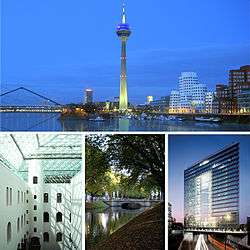 Düsseldorf skyline with Rheinturm and Neuer Zollhof, inside Kunstsammlung Nordrhein-Westfalen, Germany's busiest and upscale shopping street Königsallee and Stadttor | |
 Flag  Coat of arms | |
Location of Düsseldorf within North Rhine-Westphalia 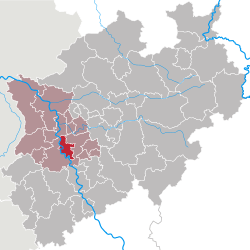 | |
 Düsseldorf 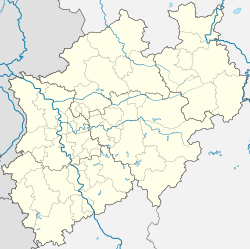 Düsseldorf | |
| Coordinates: 51°14′N 6°47′E | |
| Country | Germany |
| State | North Rhine-Westphalia |
| Admin. region | Düsseldorf |
| District | Urban district |
| Subdivisions | 10 districts, 50 boroughs |
| Government | |
| • Lord Mayor | Thomas Geisel (SPD) |
| • Governing parties | SPD / Greens / FDP |
| Area | |
| • City | 217.41 km2 (83.94 sq mi) |
| Elevation | 38 m (125 ft) |
| Population (2018-12-31)[1] | |
| • City | 619,294 |
| • Density | 2,800/km2 (7,400/sq mi) |
| • Urban | 1,220,000 |
| • Metro | 11,300,000 (Rhine-Ruhr) |
| Time zone | CET/CEST (UTC+1/+2) |
| Postal codes | 40210-40629 |
| Dialling codes | 0211, 0203 (Ortsnetz Duisburg), 02104 (Ortsnetz Mettmann) |
| Vehicle registration | D |
| Website | www.Duesseldorf.de |
Mercer's 2012 Quality of Living survey ranked Düsseldorf the sixth most livable city in the world.[6][7] Düsseldorf Airport is Germany's third-busiest airport after those of Frankfurt and Munich, serving as the most important international airport for the inhabitants of the densely populated Ruhr, Germany's largest urban area. Düsseldorf is an international business and financial centre, renowned for its fashion and trade fairs,[8][9][10] and is headquarters to one Fortune Global 500 and two DAX companies. Messe Düsseldorf organises nearly one fifth of premier trade shows.[11] As second largest city of the Rhineland, Düsseldorf holds Rhenish Carnival celebrations every year in February/March, the Düsseldorf carnival celebrations being the third most popular in Germany after those held in Cologne and Mainz.[12]
There are 22 institutions of higher education in the city including the Heinrich-Heine-Universität Düsseldorf, the university of applied sciences (Hochschule Düsseldorf), the academy of arts (Kunstakademie Düsseldorf) (Joseph Beuys, Emanuel Leutze, August Macke, Gerhard Richter, Sigmar Polke, and Andreas Gursky), and the university of music (Robert-Schumann-Musikhochschule Düsseldorf). The city is also known for its pioneering influence on electronic/experimental music (Kraftwerk) and its Japanese community.
History
| Historical population | ||
|---|---|---|
| Year | Pop. | ±% |
| 1555 | 3,500 | — |
| 1703 | 7,000 | +100.0% |
| 1800 | 12,102 | +72.9% |
| 1871 | 69,365 | +473.2% |
| 1895 | 175,985 | +153.7% |
| 1905 | 253,274 | +43.9% |
| 1919 | 407,338 | +60.8% |
| 1925 | 432,633 | +6.2% |
| 1933 | 498,600 | +15.2% |
| 1939 | 541,410 | +8.6% |
| 1950 | 500,516 | −7.6% |
| 1961 | 702,596 | +40.4% |
| 1970 | 663,586 | −5.6% |
| 1987 | 563,531 | −15.1% |
| 2001 | 570,765 | +1.3% |
| 2011 | 586,291 | +2.7% |
| 2018 | 619,294 | +5.6% |
| Population size may be affected by changes in administrative divisions. Source:[13] | ||
Early development
When the Roman Empire was strengthening its position throughout Europe, a few Germanic tribes clung on in marshy territory off the eastern banks of the Rhine.[14] In the 7th and 8th centuries, the odd farming or fishing settlement could be found at the point where the small river Düssel flows into the Rhine. It was from such settlements that the city of Düsseldorf grew.
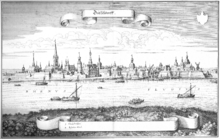
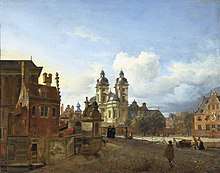
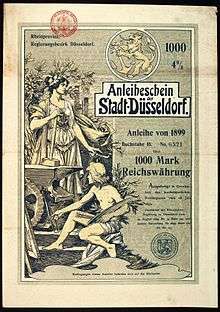
The first written mention of Düsseldorf (then called Dusseldorp in the local Low Rhenish dialect) dates back to 1135. Under Emperor Friedrich Barbarossa the small town of Kaiserswerth to the north of Düsseldorf became a well-fortified outpost, where soldiers kept a watchful eye on every movement on the Rhine. Kaiserswerth eventually became a suburb of Düsseldorf in 1929. In 1186, Düsseldorf came under the rule of the Counts of Berg. 14 August 1288 is one of the most important dates in the history of Düsseldorf. On this day the sovereign Count Adolf VIII of Berg granted the village on the banks of the Düssel town privileges. Before this, a bloody struggle for power had taken place between the Archbishop of Cologne and the count of Berg, culminating in the Battle of Worringen.
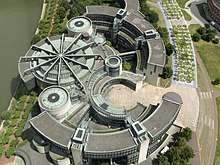
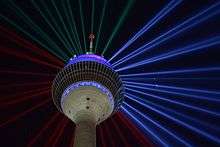
The Archbishop of Cologne's forces were wiped out by the forces of the count of Berg who were supported by citizens and farmers of Cologne and Düsseldorf, paving the way for Düsseldorf's elevation to city status, which is commemorated today by a monument on the Burgplatz. The custom of turning cartwheels is credited to the children of Düsseldorf. There are variations of the origin[16] of the cartwheeling children. Today the symbol (Der Radschläger)[16] represents the story and every year the Düsseldorfers celebrate by having a cartwheeling contest. After this battle the relationship between the four cities deteriorated, because they were commercial rivals; it is often said that there is a kind of hostility between the citizens of Cologne and Düsseldorf. Today, it finds its expression mainly in a humorous form (especially during the Rhineland Karneval) and in sports.
A market square sprang up on the banks of the Rhine and the square was protected by city walls on all four sides. In 1380, the dukes of Berg moved their seat to the town and Düsseldorf was made regional capital of the Duchy of Berg. During the following centuries several famous landmarks were built, including the Collegiate Church of St Lambertus. In 1609, the ducal line of the United Duchies of Jülich-Cleves-Berg died out, and after a virulent struggle over succession, Jülich and Berg fell to the Wittelsbach Counts of Palatinate-Neuburg, who made Düsseldorf their main domicile, even after they inherited the Electorate of the Palatinate, in 1685, becoming now Prince-electors as Electors Palatine.
Under the art-loving Johann Wilhelm II (r. 1690–1716), a vast art gallery with a huge selection of paintings and sculptures, were housed in the Stadtschloss (city castle). After his death, the city fell on hard times again, especially after Elector Charles Theodore inherited Bavaria and moved the electoral court to Munich. With him he took the art collection, which became part of what is now the Alte Pinakothek in Munich. Destruction and poverty struck Düsseldorf after the Napoleonic Wars. Napoleon made Berg a Grand Duchy and Düsseldorf its capital. Johann Devaranne, a leader of Solingen's resistance to Napoleon's conscription decrees, was executed here in 1813. After Napoleon's defeat, the whole Rhineland including Berg was given to the Kingdom of Prussia in 1815. The Rhine Province's parliament was established in Düsseldorf. By the mid-19th century, Düsseldorf enjoyed a revival thanks to the Industrial Revolution as the city boasted 100,000 inhabitants by 1882; the figure doubled in 1892.
World War I
During World War I the Royal Naval Air Service (RNS) undertook the first Entente strategic bombing missions on 22 September 1914, when it bombed the Zeppelin bases in Düsseldorf.[17][18]
Weimar Republic
In 1920, Düsseldorf became the centre of the General Strike. On 15 April 1920, 45 delegates of the German Miners Union were murdered by the Freikorps.[19]
World War II
The city was a target of strategic bombing during World War II, particularly during the RAF bombing campaign in 1943 when over 700 bombers were used in a single night. Raids continued late into the war. As part of the campaign against German oil facilities, the RAF raid of 20–21 February on the Rhenania Ossag refinery in the Reisholz district of the city halted oil production there. The Allied ground advance into Germany reached Düsseldorf in mid-April 1945. The United States 97th Infantry Division easily captured the city on 18 April 1945,[20] after the local German Resistance group launched Aktion Rheinland.
German Federal Republic
In 1946, Düsseldorf was made capital of the new federal state of North Rhine-Westphalia. The city's reconstruction proceeded at a frantic pace and the economic transformation guided Düsseldorf's economic growth.
Geography
Physical geography
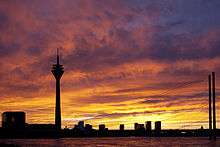
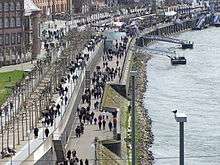
Düsseldorf lies at the centre of the Lower Rhine basin, where the delta of the Düssel flows into the Rhine. The city lies on the east side of the Rhine, except District 4 (Oberkassel, Niederkassel, Heerdt and Lörick). Across the Rhine, the city of Neuss stands on the delta of the Erft. Düsseldorf lies southwest of the Ruhr urban area, and in the middle of the Rhine-Ruhr metropolitan region.
Düsseldorf is built entirely on alluvium, mud, sand, clay and occasionally gravel. The highest point in Düsseldorf is the top of Sandberg in the far eastern part of the city (Hubbelrath borough) at 165 metres (541 ft). The lowest point is at the far northern end in Wittlaer borough where the Schwarzbach enters the Rhine, with an average elevation of 28 metres (92 ft).
Adjacent cities and districts
The following districts and cities border Düsseldorf (clockwise starting from the north): the City of Duisburg, the District of Mettmann (Ratingen, Mettmann, Erkrath, Hilden, Langenfeld, and Monheim), and the District of Neuss (Dormagen, Neuss, and Meerbusch).
Climate
The city has an oceanic climate (Köppen: Cfb, mild in relation to East Germany).[21] Like the rest of the lower Rhineland, Düsseldorf experiences moderate winters with little snowfall and mild to warm summers. The average annual temperature is 10.6 °C (51 °F) with an average yearly precipitation of 797 millimetres (31 in). The dominant wind direction is from the west with velocities in the range of 3 to 4 m/s (7–9 mph), with gusts of 3.5 −4.8 m/s (8–10.7 mph). The wind is calm (defined as being under 2 m/s or 4.5 mph) about 35% of the time, more frequently at night and in the winter.[22][23]
| Climate data for Düsseldorf, 1985–2015 normals | |||||||||||||
|---|---|---|---|---|---|---|---|---|---|---|---|---|---|
| Month | Jan | Feb | Mar | Apr | May | Jun | Jul | Aug | Sep | Oct | Nov | Dec | Year |
| Average high °C (°F) | 6 (43) |
7 (45) |
11 (52) |
15 (59) |
19 (66) |
22 (72) |
24 (75) |
24 (75) |
20 (68) |
15 (59) |
10 (50) |
6 (43) |
15 (59) |
| Daily mean °C (°F) | 3 (37) |
4 (39) |
7 (45) |
10 (50) |
14 (57) |
16 (61) |
19 (66) |
18 (64) |
15 (59) |
11 (52) |
7 (45) |
4 (39) |
11 (51) |
| Average low °C (°F) | 1 (34) |
1 (34) |
3 (37) |
5 (41) |
9 (48) |
11 (52) |
14 (57) |
14 (57) |
10 (50) |
8 (46) |
4 (39) |
2 (36) |
7 (44) |
| Average rainfall mm (inches) | 37.6 (1.48) |
32.5 (1.28) |
33.4 (1.31) |
24 (0.9) |
32.8 (1.29) |
34.5 (1.36) |
39.7 (1.56) |
33.8 (1.33) |
32.6 (1.28) |
35.7 (1.41) |
39.2 (1.54) |
47.9 (1.89) |
423.7 (16.63) |
| Average relative humidity (%) | 86 | 83 | 77 | 71 | 70 | 71 | 72 | 74 | 81 | 84 | 88 | 88 | 79 |
| Source: timeandate.com | |||||||||||||
| Climate data for Düsseldorf (1990–2013) | |||||||||||||
|---|---|---|---|---|---|---|---|---|---|---|---|---|---|
| Month | Jan | Feb | Mar | Apr | May | Jun | Jul | Aug | Sep | Oct | Nov | Dec | Year |
| Average high °C (°F) | 5.5 (41.9) |
6.9 (44.4) |
10.9 (51.6) |
15.2 (59.4) |
19.4 (66.9) |
22.1 (71.8) |
24.3 (75.7) |
24.0 (75.2) |
19.8 (67.6) |
15.0 (59.0) |
9.5 (49.1) |
5.7 (42.3) |
14.9 (58.8) |
| Daily mean °C (°F) | 3.4 (38.1) |
4.1 (39.4) |
7.1 (44.8) |
10.4 (50.7) |
14.4 (57.9) |
17.1 (62.8) |
19.4 (66.9) |
19.1 (66.4) |
15.5 (59.9) |
11.6 (52.9) |
7.1 (44.8) |
3.7 (38.7) |
11.1 (52.0) |
| Average low °C (°F) | 1.2 (34.2) |
1.3 (34.3) |
3.3 (37.9) |
5.5 (41.9) |
9.3 (48.7) |
12.0 (53.6) |
14.4 (57.9) |
14.1 (57.4) |
11.2 (52.2) |
8.1 (46.6) |
4.6 (40.3) |
1.7 (35.1) |
7.3 (45.1) |
| Average precipitation mm (inches) | 61.1 (2.41) |
55.7 (2.19) |
54.6 (2.15) |
50.8 (2.00) |
57.6 (2.27) |
71.5 (2.81) |
77.0 (3.03) |
74.5 (2.93) |
100.5 (3.96) |
65.3 (2.57) |
66.1 (2.60) |
71.1 (2.80) |
805.8 (31.72) |
| Mean monthly sunshine hours | 55.7 | 76.2 | 112.2 | 165.0 | 198.8 | 194.0 | 207.6 | 190.7 | 140.1 | 110.4 | 59.0 | 45.2 | 1,554.9 |
| Source: www.weatheronline.de, Sun = http://meteo-climat-bzh.dyndns.org | |||||||||||||
Demographics
| Largest groups of foreign residents | |
| Nationality | Population (31.12.2017) |
|---|---|
| 12,707 | |
| 10,388 | |
| 9,316 | |
| 7,799 | |
| 5,829 | |
| 5,820 | |
| 4,856 | |
| 4,541 | |
| 4,477 | |
| 4,430 | |
| 4,251 | |
| 3,842 | |
| 3,720 | |
| 3,328 | |
| 3,266 | |
| 3,079 | |
| 2,962 | |
With a population of 612,178 within the city boundaries (31 December 2015),[32] Düsseldorf is Germany's seventh largest city. Its population surpassed the threshold of 100,000 inhabitants during the height of industrialisation in 1882, and peaked at just over 705,000 in 1962. The city then began to lose residents with many moving into neighbouring municipalities. However, since the late 1990s, the city's population has been slowly rising again.
A total of 109,883[33] (18%) of Düsseldorf's population are foreigners (31 December 2008), the majority of whom come from within Europe (81,742). The largest national minorities are Turks, Greeks, and Poles. Düsseldorf and its surroundings have the third-largest Japanese community in Europe and the largest in Germany (about 11,000 people).[34][35] Düsseldorf has the third-largest Jewish community in Germany, with about 7,000 members.[36][37][38]
Government
Mayors
Districts
Since 1975, Düsseldorf is divided into ten administrative districts. Each district (Bezirk) has its own elected district council (Bezirksvertretung) and its own district mayor (Bezirksvorsteher). The district councils are advisory only. Each district is further subdivided into boroughs. There are 50 boroughs in Düsseldorf.[39]
|
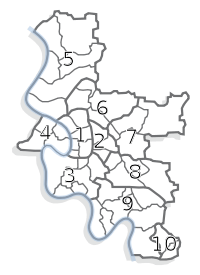 |
|
Economy
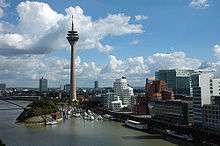
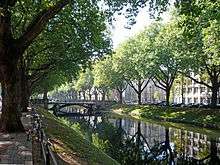
Düsseldorf has become one of the top telecommunications centres in Germany. With two of the four big German providers of mobile frequencies, D2 Vodafone and E-Plus, Düsseldorf leads the German mobile phone market. There are many foreign information and communication technology companies in Düsseldorf such as Huawei, NTT, Ericsson, Nokia, and GTS.. There are 18 internet service providers located in the capital of North-Rhine Westphalia. There are two airlines with headquarters in the city: Eurowings and formerly independent LTU International.[40]
Many of the internet companies in Düsseldorf have their roots in the world of advertising: there are 400 advertising agencies in Düsseldorf, among them three of the largest in Germany: BBDO Group, Grey Global Group and Publicis. A number of affiliates of foreign agencies deserve mention as well, such as Ogilvy & Mather, Dentsu, Hakuhodo, and DDB. There are also about 200 publishing houses in Düsseldorf.
Peek & Cloppenburg (fashion); Uniper (electricity generation); L'Oréal Germany (Cosmetics and Beauty); Henkel AG & Co. KGaA (Branded Consumer Goods and Industrial technologies); Metro (wholesale, retail); Ceconomy (retail); Esprit Holdings (fashion, headquarters in Ratingen near Düsseldorf); BASF Personal Care & Nutrition (formerly Cognis – chemicals, headquarter in Monheim near Düsseldorf, but production mainly in Düsseldorf).
Daimler AG builds the Mercedes-Benz Sprinter light commercial vehicles in Düsseldorf. Since the 1960s, there has been a strong relationship between the city and Japan. Many Japanese banks and corporations have their European headquarters in Düsseldorf – so many that Düsseldorf has the third largest Japanese community in Europe, after London and Paris.[34][35]
The "Kö", which stands for Königsallee ("King's Avenue"), is a shopping destination. Some jewellery shops, designer labels, and galleries have their stores here. The Kö has among the highest rents for retail and office space in Germany.[41]
Financial center
The city is also an important financial center.[42] More than 30.000 people are working for the financial and insurance sector in Düsseldorf.[43] There are around 170 national and international financial institutions, and about 130 insurance agencies, and one of Germany's eight stock exchanges. HSBC has its German headquarter in Düsseldorf and employs 3.000 people. NRW.BANK is a development bank of the State of North Rhine-Westphalia and the largest state development bank in Germany. NRW.BANK was spun off from WestLB in 2002. Today Deutsche Bank and Commerzbank have major branches in Düsseldorf with about 2.000 employees. Düsseldorf is also the most important German financial center for Japanese credit institutions. MUFG Bank, SMBC and Mizuho have their German headquarter in Düsseldorf. Also Santander has its German headquarter in the Düsseldorf region. Some major insurance companies like ERGO, a subsidiary of Munich Re and ARAG are located in the city. Several other major financial service companies have their headquarters in the city.
Media
Important newspapers and journals such as Handelsblatt, Rheinische Post, Wirtschaftswoche, Deutsches Wirtschaftsblatt and VDI-Nachrichten are published in Düsseldorf. Almost all of these papers are available online on the Internet. Renowned filmmaking companies, such as Germany's biggest cinema enterprise, the Riech-Group, and TV channels such as WDR and QVC are located in Düsseldorf. The foundation Film- und Medienstiftung NRW is supporting the production of film and new media.
In regards to movies and movie theatres in Düsseldorf, moviegoers have the option to choose between multiple different languages at the theatre. Many mainstream movies are shown in English, Spanish, French, and German.[44]
Transport
Airport DUS
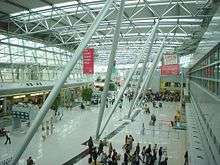
Düsseldorf Airport, also referred to as Rhein-Ruhr Airport, is located eight kilometres (5.0 miles) North from the city centre and can easily be reached by train or the S-Bahn urban railway. There is a long-distance train station served by regional and national services, which is linked to the airport by the SkyTrain, an automatic people mover. Another station situated under the terminal building carries the S-Bahn line (S11) to Düsseldorf Central Station, and to Cologne as well as a few selected night services. After Frankfurt and Munich, Düsseldorf International is Germany's third largest commercial airport, with 21,850,489 passengers annually (2014). The airport offers 180 destinations on 4 continents, and is served by 70 airlines. The airport buildings were partly destroyed by a devastating fire caused by welding works in 1996, killing 17 people. It was completely rebuilt and the Skytrain installed.
Railway
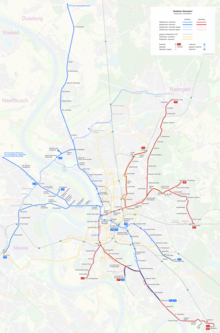
The city is a major hub in the Deutsche Bahn (DB) railway network. More than 1,000 trains stop in Düsseldorf daily. Düsseldorf Central Station at Konrad-Adenauer-Platz is located in Düsseldorf-Stadtmitte. Several Rhein-Ruhr S-Bahn lines connect Düsseldorf to other cities of Rhine-Ruhr. Local Düsseldorf Straßenbahn and light rail Düsseldorf Stadtbahn traffic, as well as local bus traffic, is carried out by the city-owned Rheinbahn which operates within the VRR public transport system. The light rail system also serves neighbouring cities and is partially operated underground. The Central Station and the Airport Station (Flughafen-Bahnhof) are connected to the national and European high-speed systems (Intercity/Eurocity, IC/EC and InterCityExpress).
Taxi
In Düsseldorf there are 1320 officially licensed Taxis. According to the regulations, the cars are always in ivory colour. On the back window you always find a black number on a yellow patch. Credit card payment has to be accepted at the Taxi stands at Airport of Düsseldorf. The supply of taxis in Düsseldorf is over the German average. Two taxi organisations cover the market. "Taxi-Düsseldorf" offers more than 1180 cabs in different sizes for max. 8 Passengers. The smaller one is "Rhein-Taxi" with more than 120 cabs. It is obligatory to carry out any journeys to destinations in the city and directly neighbouring cities.[45]
Carsharing
In addition to stationary car sharing, where vehicles must be returned to their original location after use, socalled One-way carsharing vehicles have also been available for hire since 2012. These vehicles, which can be parked anywhere where parking is normally allowed within Düsseldorf, can be rented from Car2go, Greenwheels, Stadtmobil and DriveNow.[46]
Autobahn
North Rhine-Westphalia has the densest network of autobahns in Germany and Düsseldorf is directly accessible via the A3, A44, A46, A52, A57, A59 and A524.
Cycling
Düsseldorf is connected to some national and international cycling paths, including EV15 The Rhine Cycle Route.
The city of Düsseldorf is a member of the German North Rhine-Westphalia District, Municipality and City Friends of Pedestrians and Cyclists Working Group, who bestowed upon Düsseldorf the title of "Friend of Cyclists City" in 2007, although the city still has a few gaps in the network of cycle paths in the eyes of many of its citizens.
Culture and recreation
Elector Jan Wellem and his wife Anna Maria Luisa de' Medici of Tuscany, were patrons of Düsseldorf's first significant cultural activities in the 17th and 18th centuries. Heinrich Heine, whose 200th birthday was celebrated in 1997 and who originally had a proposed memorial in the city dedicated to him; Clara and Robert Schumann; and as Felix Mendelssohn, are the most prominent artists related to the city, which is home to a distinguished Academy of Fine Arts.
The Düsseldorf cultural scene comprises traditional and avant-garde, classical and glamorous. The world-famous state art collection of North Rhine-Westphalia, the highly acclaimed Deutsche Oper am Rhein (opera), and the Düsseldorfer Schauspielhaus (theatre), artistic home of Gustaf Gründgens, are major elements of Düsseldorf's reputation as a centre of the fine arts.
Beer
Düsseldorf is well known for its Altbier,[47] a hoppy beer which translates as old [style] beer, a reference to the pre-lager brewing method of using a warm top-fermenting yeast like British pale ales.[48] Over time the Alt yeast adjusted to lower temperatures, and the Alt brewers would store or lager the beer after fermentation, leading to a cleaner, crisper beer. The name "altbier" first appeared in the 19th century to differentiate the beers of Düsseldorf from the new pale lager that was gaining a hold on Germany.[49]
Brewers in Düsseldorf used the pale malts that were used for the modern pale lagers, but retained the old ("alt") method of using warm fermenting yeasts. The first brewery to use the name Alt was Schumacher which opened in 1838.[50] The founder, Mathias Schumacher, allowed the beer to mature in cool conditions in wooden casks for longer than normal, and laid the foundation for the modern alt – amber coloured and lagered.[51] The result is a pale beer that has some of the lean dryness of a lager but with fruity notes as well.[52]
There are five pub-breweries in Düsseldorf which brew Altbier on the premises: Füchschen, Schumacher, Schlüssel, Uerige and Brauerei Kürzer. Four of the five are in the historic centre of Düsseldorf (Altstadt); the other (Schumacher), between the Altstadt and Düsseldorf Central railway station (Hauptbahnhof), also maintains an establishment in the Altstadt, Im Goldenen Kessel, across the street from Schlüssel.
Each (except Brauerei Kürzer) produces a special, secret, seasonal "Sticke" version in small quantities, though the names vary: Schlüssel spells it "Stike", without the "c", while Schumacher calls its special beer "Latzenbier", meaning "slat beer", possibly because the kegs from which it was poured had been stored on raised shelves.[53] Füchschen's seasonal is its Weihnachtsbier (Christmas beer), available in bottles starting mid-November, and served in the brewpub on Christmas Eve.[54]
Music and nightlife
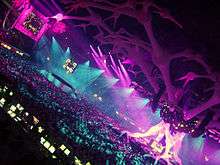
Since the 1950s the "Kom(m)ödchen" has been one of the most prominent political cabarets of Germany. The city's most famous contribution to the culture of modern popular music is beyond doubt the influential avant-garde electronic band Kraftwerk. Formed by a few Düsseldorf-born musicians, Kraftwerk is internationally known as the most significant band in the history of post-war German music and as pioneers in electronic music.[55] Other influential musical groups originating from Düsseldorf include Neu!, formed in 1971 by Klaus Dinger and Michael Rother, after their split from Kraftwerk,[56] and La Düsseldorf, also formed by Dinger in 1976 shortly after Neu! disbanded. Both groups had a significant influence on a variety of subsequent rock, post-punk, and electronic music artists.[57]
Internationally known power metal band Warlock was formed in Düsseldorf in 1982. Its frontwoman, Doro Pesch, had a successful solo career in Europe and Asia since Warlock ended. The punk band Die Toten Hosen, which is famous around the world, also the most popular singers in Germany Westernhagen and Heino come from Düsseldorf. The electronic act D.A.F. was formed in the city in 1978, as well as the electronic/industrial pioneers Die Krupps in 1980. Another famous formation is Fehlfarben. Founded in the late 1970s by Peter Hein, Frank Fenstermacher, Kurt Dahlke and Michael Kemner.
Düsseldorf appears in several songs, including Düsseldorf by the British indie band Teleman and Wärst du doch in Düsseldorf geblieben by Danish singer Dorthe Kollo.
Fashion
Düsseldorf, Germany is the fashion capital of Germany as it is a major cultural center for the art and fashion scenes. The fashionable clothes trend took root in this city before 1949. 1949 is the date of the first fashion show staged in Düsseldorf. Fashion trends have occurred as access to more elegant clothing for the general public has been a part of the culture for almost a century. Two times a year an event called the, “Voices of Fashion,” occurs and attracts many people to visit Düsseldorf to find the latest fashion items. There are famous designers that have made a name for themselves in Düsseldorf as well. Designers Sabine Schumacher, Peter O. Mahler, and Renate Harvan all design in Düsseldorf. To keep the creativity and passion for fashion alive in Düsseldorf everyday there are schools dedicated to fashion design in Düsseldorf as well. Akademie Mode and Design Institution, Design Department Academy, and Mode Design College are the three prominent fashion schools residing in Düsseldorf.[58]
Carnival
One of the biggest cultural events in Düsseldorf is the Karneval (also referred to as the "fifth season") which starts every year on 11 November at 11:11 a.m., and reaches its climax on Rosenmontag (Rose Monday), featuring a huge parade through the streets of Düsseldorf. Karneval ends on Aschermittwoch (Ash Wednesday).
Cartwheeler of Düsseldorf
The Düsseldorfer Radschläger (Boy who does Cartwheels) is said to be the city's oldest tradition. The symbol of the cartwheeler can be found on many souvenirs and various things in Düsseldorf have the cartwheelers to thank for their names. This tradition was honoured in 1954 by the erection of a fountain, called Cartwheeler's Fountain, on the Burgplatz in Düsseldorf.
Legends of its origin and history
The tradition cannot be linked to one specific historical event, instead, there are several stories surrounding the beginnings of the Düsseldorf Cartwheelers. Probably the most well known version is Battle of Worringen. In the battle of 1288 Count Adolf devastatingly defeated the Archbishop of Cologne. As a consequence of this victory, Düsseldorf obtained Town privileges. The inhabitants, especially the children ran joyfully on the streets and performed cartwheels.
Another story talks about a wedding procession during which one of the wheels of the wedding carriage broke. In order to fend off the threat of bad luck, a boy supposedly jumped to the carriage, took hold of the wheel and thus became a living part of the wheel. Whether the story is about the marriage of Jan Wellem and Anna Maria Luisa de' Medici or the wedding of Margravine Jakobea of Baden and Johann Wilhelm is debatable.
Another story gives an account of this wedding between Margrave Jacobe von Baden and Johann Wilhelm, in 1585. According to legend she felt miserable about her marriage, but the cartwheelers who displayed their skills next to her carriage were able to make her smile. Numerous travelers were attracted to the city by great exhibitions – the forerunner of today's fairs – between the end of the 19th century and the beginning of the 20th century. During this time the children who did the cart wheeling found out that it was a profitable source of income. The bourgeoisie accepted this in good humour as a symbolic act of local patriotism. In the beginning the lads shouted "för eene Penning schlage ich das Rad“ (cartwheel for a penny). The Jan Wellem monument returned to Düsseldorf at the end of the Second World War. The procession was accompanied by torches, fanfares and the cartwheeling boys.
Cartwheelers in the cityscape
Cartwheelers can be found by several fountains within the city and near many small landmarks. The most famous is Cartwheeler's Fountain in Burgplatz with an inscription of a quote by Hans Müller-Schlösser: "Radschläger wolle mer blieve, wie jeck et de Minschen och drieve“ (We will always remain cartwheelers, however crazy it drives people.) The fountain was designed by Alfred Zschorsch in 1954 and donated by the Heimatverein Düsseldorfer Jonges, which is a club devoted to the maintenance of local and regional traditions. There are other cartwheelers that decorate storm drains and the door knocker on the Church of Lambertus, which was designed by Friedrich Becker. He created the cartwheeler in front of the Schadow Arcades.
This tradition has been kept alive by the Alde Düsseldorfer Bürgergesellschaft von 1920 e. V., a society founded in 1920, who organized the first cartwheeler competition on 17 October 1937. Since 1971 this event has been held annually[59] in cooperation with the Stadtsparkasse (a local bank), but formerly took place in the Königsallee. Since 2006 it has taken place on the Rheinwerft, near the old part of town. This is a fixed date in the city’s calendar of events. About 500 boys regularly participate in this event and since 1971 girls have also taken part. In 2001 the art project Radschläger-Kunst (Cartwheeler Art) was called into life, in which over 100 cartwheeler sculptures have been designed by various artists. The door knocker on the Church of Lambertus functioned as a model for the sculptures that are 2 metres (6 feet 7 inches) high, 2 metres (6 feet 7 inches) wide and 30 cm (12 in) deep. They were positioned around the city centre. Some of the sculptures have been auctioned off to companies and private owners.
Christmas market
Every Christmas, the city of Düsseldorf uses the city centre to host one of the largest Christmas gatherings in Germany. The Christmas festival occurs every year from 17 November until 23 December. This Christmas fest brings Düsseldorf a large portion of tourism every year as many people from nearby areas come to the city to drink mulled wine and hot chocolate and watch craftsman blow glass and create art. The event contains many small wooden buildings all clustered in the middle of the city for all the citizens to enjoy. The event, to many visitors, has an old European feel, but is very lively.
Cuisine
.jpg)
Traditional meals in the region are Rheinischer Sauerbraten (a beef roast and sometimes horse marinated for a few days in vinegar and spices served with gravy and raisins) and Heaven and Earth (Himmel und Äd; black pudding with stewed apples mixed with mashed potatoes). In winter the people like to eat Muscheln Rheinischer Art (Rhenish-style mussels) as well as Reibekuchen (fried potato pancake served with apple sauce). Also a special meal: Düsseldorfer Senfrostbraten (Steaks roasted with Düsseldorf mustard on top).
Düsseldorf is known for its strong Dijon-like mustard served in a traditional pot called "Mostertpöttche", which was eternalised in a still life by Vincent van Gogh in 1884.[60]
The Rhine Metropolis is one of the most diverse areas in terms of culinary diversity. Düsseldorf, with the third largest Japanese community in Europe, not only provides a wide range of culinary cuisine but also has a solid foundation of Authentic Asian food in the city. Düsseldorf's exceptional culinary cuisine has been recognized and visited by the Worldwide leading travel guide of Lonely Planet. Along with a broad range of diverse cultural cuisine, Düsseldorf is also home to various Michelin starred restaurants that are world renowned.[61]
Halve Hahn – this dish is made from a half a double rye roll, which is another of the specialties of Düsseldorf, buttered, with a thick slice of aged Gouda cheese, onions, mustard, ground paprika and sour pickles.
Himmel un Aad – a dish of mashed potatoes and apples along with slices of blutwurst. Caramelized onions are usually served with this meal.
Reibekuchen is another famous dish from Düsseldorf; this dish is usually drizzled with Rübensyrup (beet syrup) and is served on pumpernickel slices along with applesauce[62]
Literature
The Förderpreis für Literatur der Landeshauptstadt Düsseldorf is a German Literary award donated by the City of Düsseldorf in Northrhine-Westphalia.[63] The Prize for Literature in support of the City of Düsseldorf is awarded since 1972 by the Council of the City due to the decisions of the courts.[64]
The Förderpreis für Literatur der Landeshauptstadt Düsseldorf is given once a year to artists and groups, especially to the areas of poetry, writing, review and translation.[65]
Rivalry with Cologne
Düsseldorf and Cologne have a "fierce regional rivalry".[66] The rivalry includes carnival parades, football, ice hockey and beer.[66] People in Cologne prefer Kölsch while people in Düsseldorf prefer Alt.[66] Waiters and patrons will "scorn" and make a "mockery" of people who order Alt beer in Cologne and Kölsch in Düsseldorf.[66] The rivalry has been described as a "love-hate relationship".[66]
Theatres

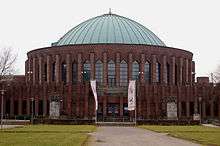
- Apollo (varieté, circus; shows do not require knowledge of German language)
- Capitol (musicals)
- Deutsche Oper am Rhein (Opera; Ballet)
- Düsseldorfer Schauspielhaus; the theatre started with theatrical performances in 1585
- Düsseldorfer Marionetten-Theater
- Merkur Spiel-Arena (Venue of the Eurovision Song Contest 2011)
- FFT – Forum Freies Theater (intimate theatre)
- Junges Theater in der Altstadt
- Klangraum (20th-century classical music)
- Kom(m)ödchen (Political cabaret)
- Komödie Düsseldorf
- Palais Wittgenstein
- Puppentheater an der Helmholtzstraße (puppetry)
- Robert-Schumann-Saal
- Savoy-Theater
- Seniorentheater in der Altstadt
- Tanzhaus NRW (theatre for dance)
- Tonhalle Düsseldorf (concert hall for classical music, jazz, pop, cabaret)
- Theater an der Kö
- Theater an der Luegallee
- Theateratelier Takelgarn
- Theater Flin
- Theater Glorreich
Museums, arts and history institutes, and other attractions
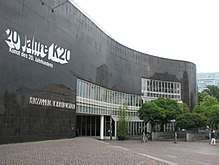
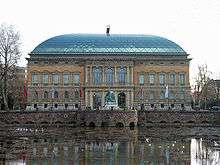
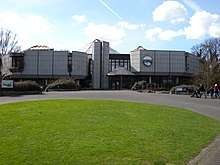

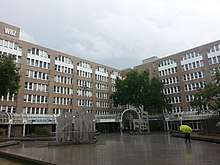
- Akademie-Galerie (exhibition space of the Art Academy Düsseldorf)
- Andreaskirche
- Aquazoo-Löbbecke-Museum (aquarium and zoological museum)[67]
- TvTower[68]
- BRAUSE – Vereinsheim des Metzgerei Schnitzel Kunstvereins e.V.
- Film museum[69]
- Filmstiftung NRW (NRW Film Foundation)
- Forum NRW
- Goethe-Museum
- Heinrich-Heine-Institut
- Heinrich Heine Birth-house
- Hetjens Museum (German museum of ceramics)
- Imai – inter media art institute
- Institut Français Düsseldorf
- Institut für Kunstdokumentation und Szenografie[70] (Institute for Art Documentation and Scenography)
- Julia Stoschek Collection[71] (video art)
- KAI 10|Raum für Kunst[72]
- Kulturbahnhof Eller[73]
- Kunstarchiv Kaiserswerth (works of Bernd and Hilla Becher/Kahmen Collection)
- Kunst im Tunnel (KIT)[74]
- Kunstsammlung Nordrhein-Westfalen (Art Collection Northrhine-Westphalia) – K20 (Grabbeplatz) and K21 (Ständehaus)
- Kunsthalle Düsseldorf
- Kunstverein für die Rheinlande und Westfalen (Society for the Promotion of the Fine Arts)
- Museum Kunst Palast
- Mahn- und Gedenkstätte für die Opfer des Nationalsozialmus (Memorial museum for victims of Nationalsocialism)
- Onomato[75]
- Polnisches Institut Düsseldorf[76]
- Puppentheater an der Helmholtzstraße
- Rathaus
- Reinraum e.V. – Verein zur Förderung von Kunst und Kultur
- Rheinturm (Rhine Tower; highest building and landmark of Düsseldorf)
- St. Lambertuskirche
- Schiffahrt Museum
- Schloss Jägerhof
- Schlossturm
- Schloss und Park Benrath (Palace and park of Benrath)
- Stadtbibliothek
- Stadtmuseum (City history museum)
- Statue of Jan Wellem
- Theatermuseum, Düsseldorf
- Triton Museum
- Volkshochschule
- Zakk[77] – cultural centre with concerts, readings, debates and party
Parks and gardens
- Botanischer Garten Düsseldorf, a modern botanical garden
- Hofgarten
- The Nordpark, with the Aquazoo
- The Südfriedhof (The South Cemetery)
- Volksgarten adjacent to Südpark
Sports
 The ISS-Dome, an ice hockey stadium, opened in 2006.
The ISS-Dome, an ice hockey stadium, opened in 2006. The Merkur Spiel-Arena (formerly LTU Arena)
The Merkur Spiel-Arena (formerly LTU Arena)- Logo during Eurovision Song Contest 2011 ESC
- Racecourse, general view from the east
- Main Tribune of the Racecourse for horses/Galopprennbahn Düsseldorf
Düsseldorf's main football team Fortuna Düsseldorf won the 1933 German championship, the German Cup in 1979 and 1980, and were finalists in the European Cup Winners Cup in 1979. They currently play in the Bundesliga, after being promoted from the 2. Bundesliga in 2018. They play their matches in the Merkur Spiel-Arena (formerly known as the 'ESPIRIT arena'), a multi-functional stadium with a capacity of 54,500. Düsseldorf was one of nine host cities for the 1974 FIFA World Cup, and the Rochusclub Düsseldorf has hosted the tennis World Team Cup from 1978 till 2012.[78] Düsseldorf also held the Grand Départ for the Tour de France in July 2017.[79]
Other sports in Düsseldorf are ice hockey (the Düsseldorfer EG which play in the new ISS-Dome) and American football. The Düsseldorf Panther are one of the most successful teams in Germany with six German Bowl titles and the Eurobowl victory in 1995. In addition the Junior-Team is the most successful youth department in Germany with fifteen Junior Bowl victories. Rhine Fire Düsseldorf was an established team of the NFL Europe and won the World Bowl two times in 1998 and 2000. Düsseldorf has a successful rugby union team (Düsseldorf Dragons), who as of 2017/18 play in the western division of the 2. Bundesliga, the second tier of German rugby.[80]
Table tennis is also played (Borussia Düsseldorf – the most successful team in Germany with Timo Boll), as are handball (HSG Düsseldorf), basketball (Düsseldorf Giants), baseball (Düsseldorf Senators) and dancing (Rot-Weiß Düsseldorf). Düsseldorf also has a Cricket team, the Düsseldorf Blackcaps, who play in the regional NRW league.[81]
Education
Heinrich Heine University Düsseldorf is located in the southern part of the city. It has about 30,000 students and a wide range of subjects in natural sciences, mathematics, computer sciences, philosophy, social sciences, arts, languages, medicine, pharmacy, economy and the law.
Other academic institutions include
- the Clara Schumann Musikschule (music school)
- the Robert Schumann Hochschule
- the Kunstakademie Düsseldorf[82] (Academy of Fine Arts) which is famous for high-profile artists like Joseph Beuys, Paul Klee, Nam June Paik, Gerhard Richter, the Bechers, and Andreas Gursky
- the Hochschule Düsseldorf[83] (University of Applied Sciences)
- the AMD Academy of Fashion and Design[84]
- the Max Planck Institute for Iron Research[85]
- the Goethe Institute[86]
- Verwaltungs- und Wirtschafts-Akademie Düsseldorf
- WHU-Otto Beisheim School of Management (Düsseldorf Campus)
International primary and secondary schools:
- International School of Düsseldorf
- Lycée français de Düsseldorf
- Japanische Internationale Schule in Düsseldorf
Notable buildings
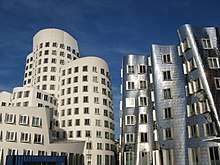
- Rheinturm (TV tower) the city's landmark (1982: 234 m [ 768 ft ], since 2004: 240.50 m [ 789.0 ft ]), the lights of which comprise the world's largest digital clock.
- The Gehry buildings in the Düsseldorf media harbour (see picture above).
- The Colorium, an 18-storey tower designed by Alsop and Partners, also in the Düsseldorf media harbour.
- The Benrather Schloss (Benrath palace).
- The Grupello-Haus probably designed by the Italian architect Matteo Alberti in 1706 for Duke Johann Wilhelm.
- The Wilhem Marx House of 1922/24: at twelve storeys high, it was Germany's first high-rise building.
- The Stahlhof of 1906, the administrative centre of Germany's steel economy until 1945.
- The Stummhaus of 1925, another early German high-rise building.
- Gerresheim Basilica.[87]
- St Suitbertus Basilica.[88]
- DRV Tower, 120-metre-high (394 ft) tower constructed in 1978.
- GAP 15, an 85-metre-high (279 ft) building constructed in 2005 near Königsallee.
- ARAG-Tower, at 131 m (430 ft) in height, it is Düsseldorf's highest office building; designed by Sir Norman Foster.
- Eight bridges span the Rhine at Düsseldorf; they, too, are city landmarks.
- Eastern pylon of Reisholz Rhine Powerline Crossing, an electricity pylon under whose legs runs a rail.
- Johanneskirche, Düsseldorf
Notable places
- Kö (Königsallee), a shopping street with luxuries shops
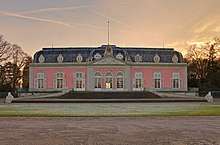 Benrath Palace, Corp de Logis
Benrath Palace, Corp de Logis - Schloss Benrath, rococo castle
- Altstadt (Düsseldorf), literally "old town", the historic town centre with the town hall Altes Rathaus from 1573. Nowadays Düsseldorf's entertainment district with hundreds of pubs and restaurants, and proverbially known by Germans as "the longest bar in the world".
- Düsseldorf-Hafen, the harbour is a modern build district
- Kaiserswerth, historical district with the ruined castle of Barbarossa Frederick I, Holy Roman Emperor
- Schloss Heltorf, the biggest palace in Düsseldorf, since 1662 homestead of the noble family Grafen von Spee
- Hofgarten, old city park
- Schloss Jägerhof, an old hunting lodge at the Hofgarten, today a Goethe Museum
Twin towns – sister cities
Düsseldorf is twinned with:[89]
In addition, Düsseldorf has friendship relations with:[92]
Notable natives
Born before 1850
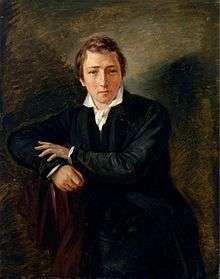
.jpg)
- Anne Of Cleves, (1515–1557) Married to Henry VIII
- François-Charles de Velbrück, (1719–1784), Prince-Bishop of Liège
- Helena Curtens, (1722–1738), last victim of the witch trials in the Lower Rhine
- Johann Georg Jacobi, (1740–1814), writer
- Friedrich Heinrich Jacobi, (1743–1819), philosopher and writer
- Peter von Cornelius, (1783–1867), painter
- Heinrich Heine, (1797–1856), poet and writer
- Lorenz Clasen (1812–1899), painter
- Wilhelm Camphausen (1818–1885), painter
- Paul Graf von Hatzfeld to Trachenberg, (1851–1901), Secretary of State and head of the Foreign Office of the German Reich 1881–1885
- Eugen Richter, (1838–1906), today part of Berlin, politician and publicist
- Arnold Forstmann, (1842–1914), landscape painter
- Peter Janssen, (1844–1908), painter, professor at the Art Academy
- Felix Klein, (1849–1925), mathematician
Born 1851–1900
_(Alter_Fritz).jpg)
- Georg Wenker, (1852–1911), linguist, founder of linguistic atlas of the German Reich (Wenkeratlas)
- Karl Janssen, (1855–1927), sculptor, professor at the Art Academy
- Fritz Reiss, (1857–1915), lithographer, illustrator, graphic artist and painter
- Bruno Schmitz, (1858–1916), architect
- Otto Hupp, (1859–1949), signature graphic artist, engraver
- Albert Herzfeld, (1865–1943), painter and author
- Agnes Elisabeth Overbeck, (1870–1919), composer and pianist
- Hanns Heinz Ewers, (1871–1943), writer and filmmaker
- Wilhelm Levison, (1876–1947), historian
- Elly Ney, (1882–1968), world-famous concert pianist
- Carl Maria Weber, (1890–1953), writer
- Willy Reetz, (1892–1963), painter, "Düsseldorf School"
- Hermann Knüfken, (1893–1976), marine soldier, revolutionary, union activist, resistance fighter and secret agent
- Ludwig Gehre, (1895–1945) in Flossenbürg, officer and resistance fighter
- Hans Globke, (1898–1973), jurist, National Socialist, from 1949 Assistant Secretary, then Secretary of State in the Federal Chancellery (1953–1963)
- Karl von Appen, (1900–1981), stage designer
Born after 1900
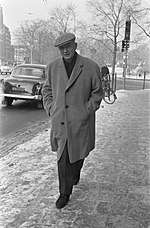
- Jacob Sporrenberg (1902–1952), SS-group leader, lieutenant general of police and politician (NSDAP) executed for war crimes
- Toni Ulmen (1906–1976), motorcycle and car race driver
- Jakob Nacken (1906–1987), tallest Nazi soldier.
- Karl Pschigode (1907–1971), actor and theatre director
- Helmut Käutner (1908–1980), film director („Des Teufels General“, „Das Haus in Montevideo“), actor
- Hilarius Gilges (1909–1933), Afro-German actor, victim of Nazism
- Ernst Klusen (1909–1988)
- Kurt Franz (1914–1998), Nazi SS commandant of Treblinka extermination camp
- Fred Beckey (1923–2017), rock climber, mountaineer, author
- Jürgen Habermas (born 1929), philosopher and sociologist
- Carl-Ludwig Wagner (1930–2012), politician (CDU)
- Wim Wenders (born 1945), filmmaker, playwright, author
- Carmen Thomas (born 1946), journalist, radio and television presenter, author and lecturer
- Marius Müller-Westernhagen (born 1948), actor and musician
- Heiner Koch (born 1954), Roman Catholic bishop
- Andreas Gursky (born 1955), photographer
- Bettina Böttinger (born 1956), TV-presenter
- Birgitt Bender (born 1956), politician (The Greens), Member of Landtag and Bundestag
- Bettina Hoffmann (born 1959), musician and musicologist
- Andreas Frege (born 1962), "Campino", singer in the band Die Toten Hosen
- René Obermann (born 1963), manager, husband of Maybrit Illner
- Doro Pesch (born 1964), heavy metal musician
- Jörg Schmadtke (born 1964), football manager
- Michael Preetz (born 1967), former football-player
- Svenja Schulze (born 1968), politician (SPD)
- Heike Makatsch (born 1971), actress and singer
- Christian Hellmich (born 1977), artist
- Tetsuya Kakihara (born 1982), voice actor and singer
- Erika Ikuta (born 1997), Japanese actress, a member of Nogizaka46
Non-natives with a connection to Düsseldorf
- William Thomas Mulvany, * 1806 Dublin, Ireland, † 30 October 1885 in Düsseldorf, entrepreneur
- Robert Schumann, born 8 June 1810 in Zwickau, † 29 July 1856 in Endenich, composer, 1850–1854 urban music director in Düsseldorf
- Alfred Rethel, born 5 May 1816 in Aachen; † 1 December 1859 in Düsseldorf, history painter
- Clara Schumann, born 13 September 1819 in Leipzig, † 20 May 1896 in Frankfurt am Main; pianist and composer, wife of Robert Schumann, frequent host of Johannes Brahms in Düsseldorf (1850–1854)
- Emanuel Leutze, born 24 May 1824 in Schwäbisch Gmünd, † 18 July 1868 in Washington, DC, painter, Düsseldorf School
- Louise Dumont, born 22 February 1862 in Cologne; † 16 May 1932 in Düsseldorf, actress and 1904 founder of the Schauspielhaus Düsseldorf
- Johanna "Mother" Ey, born 4 March 1864 in Wickrath (today Mönchengladbach); † 27 August 1947 in Düsseldorf, gallery owner
- Peter Behrens, born 14 April 1868 in Hamburg-Borgfelde, † 27 February 1940 in Berlin, architect and director of the Düsseldorf Art Academy
- Wilhelm Kreis, born 17 March 1873 in Eltville, † 13 August 1955 in Bad Honnef, architect and director of the School of Applied Arts Düsseldorf
- Peter Kürten, born 26 May 1883 in Mülheim am Rhein, † 2 July 1931 in Cologne, called "The Vampire of Düsseldorf", committed in Düsseldorf during the period between February and November 1929 series of sexual homicide
- Adolf Uzarski, born 14 April 1885 in Ruhrort (today Duisburg), † 14 July 1970 in Düsseldorf, writer, painter and graphic artist
- Emil Fahrenkamp, born 8 November 1885 in Aachen, † 24 May 1966 in Ratingen-Breitscheid, architect and director of Düsseldorf Art Academy 1937–1945
- Ernest Martin, born 23 February 1932 in New York City, theatre director, theatre manager and actor in Düsseldorf
- Betty Knox, (1906–1963) dancer with variety act Wilson, Keppel and Betty and war correspondent lived in the city during her later years and died there.[95]
See also
- Japan Day in Düsseldorf
- OPENCities
- 2017 Düsseldorf axe attack
References
- Ripuarian dialects are only spoken in the very south of the city, south of the Benrath line.
- "Bevölkerung der Gemeinden Nordrhein-Westfalens am 31. Dezember 2018" (in German). Landesbetrieb Information und Technik NRW. Retrieved 10 July 2019.
- "Dusseldorf". Collins English Dictionary. HarperCollins. Retrieved 28 February 2019.
- "Düsseldorf" (US) and "Düsseldorf". Oxford Dictionaries UK Dictionary. Oxford University Press. Retrieved 28 February 2019.
- "Düsseldorf". Merriam-Webster Dictionary. Retrieved 28 February 2019.
- 1,525,029 inhabitants for the Düsseldorf Larger Urban Zone
- "Mercer's 2011 Quality of Living survey highlights — Global". Mercer. 15 June 2011. Archived from the original on 13 May 2011. Retrieved 15 June 2011.
- Woolsey, Matt (28 April 2009). "World's 20 Best Places To Live". Forbes.com.
- "Communla Administration of Düsseldorf, 28 of July 2008" (PDF). Archived from the original (PDF) on 6 August 2009. Retrieved 16 April 2010.
- "Immobilien Zeitung: Mehr Räume für die große Modenschau vom 28. August 2008, 1 March 2009" (PDF). Archived from the original (PDF) on 18 July 2011. Retrieved 16 April 2010.
- "Cushman & Wakefield: European Cities Monitor" (PDF). Archived from the original (PDF) on 4 May 2012. Retrieved 4 June 2011.
- "Messe Düsseldorf Annual Report" (PDF). Archived from the original (PDF) on 13 July 2011. Retrieved 4 June 2011.
- 2010 survey by Jones Lang LaSalle; accessed 8 December 2014. (in German)
- Statistisches Landesamt Nordrhein-Westfalen
- Weidenhaupt, Hugo: Kleine Geschichte der Stadt Düsseldorf, Triltsch-Verlag, Düsseldorf 1979; ISBN 3-7998-0000-X. (in German)
- Jörg Nimmergut: Historische Wertpapiere – Sinnvoll sammeln – garantiert gewinnen, p. 144-145, ISBN 3894410426
- Düsseldorfer Radschläger
- Madison 2005, pp. 45–46.
- Tilford Jr. 1996, pp. 13–15.
- Birchall, Ian H./Pierre Broué/Brian Pearce, The German Revolution 1917–1923, p. 278.
- Stanton, Shelby, World War II Order of Battle: An Encyclopedic Reference to U.S. Army Ground Forces from Battalion through Division, 1939–1946 (Revised Edition, 2006), Stackpole Books, p. 174.
- "Düsseldorf, Germany Köppen Climate Classification (Weatherbase)". Weatherbase. Retrieved 13 November 2018.
- "Bezirksregierung Düsseldorf – Luftreinhalteplan (2004)" (PDF). Archived from the original (PDF) on 22 September 2006. Retrieved 1 June 2016.
- Klimaatlas – NRW (1989): Der Minister für Umwelt, Raumordnung und Landwirtschaft des Landes Nordrhein-Westfalens, Düsseldorf.
- "Statistische Informationen" (PDF). Amt 12. Retrieved 20 June 2018.
- "Statistische Informationen" (PDF). Amt 12. Retrieved 20 June 2018.
- "Statistische Informationen" (PDF). Amt 12. Retrieved 20 June 2018.
- "Statistische Informationen" (PDF). Amt 12. Retrieved 20 June 2018.
- "Statistische Informationen" (PDF). Amt 12. Retrieved 20 June 2018.
- "Statistische Informationen" (PDF). Amt 12. Retrieved 20 June 2018.
- "Statistische Informationen" (PDF). Amt 12. Retrieved 20 June 2018.
- "EU-Ausländer in Duesseldorf" (PDF). Retrieved 20 June 2018.
- "Amtliche Bevölkerungszahlen". Information und Technik Nordrhein-Westfalen. Archived from the original on 14 July 2016. Retrieved 6 October 2017.
- "Statistisches Jahrbuch der Landeshauptstadt Düsseldorf – Bevölkerung nach Nationalität" (PDF). Duesseldorf.de. Retrieved 13 July 2017.
- "Japanese Düsseldorf". VirtualTourist.com. 11 February 2003. Retrieved 6 December 2014.
- "Japantag in Düsseldorf: Welcome". Japantag-duesseldorf-nrw.de. Archived from the original on 17 February 2012. Retrieved 6 December 2014.
- "Düsseldorf | Jüdische Allgemeine". www.juedische-allgemeine.de. Retrieved 28 November 2019.
- Zeitung, Aachener. ""Bleiben wir?": Juden in Düsseldorf nach Anschlag von Halle verunsichert". Aachener Zeitung (in German). Retrieved 28 November 2019.
- Zeitung, Westdeutsche. "Düsseldorf: Antisemitismus in Düsseldorf: Jüdische Schüler werden angefeindet". Westdeutsche Zeitung (in German). Retrieved 28 November 2019.
- "Landeshauptstadt Düsseldorf – Aus den Stadtteilen". Duesseldorf.de. Archived from the original on 6 November 2014. Retrieved 8 December 2014.
- "Kontakt". Archived from the original on 6 June 2000. Retrieved 30 March 2017.CS1 maint: BOT: original-url status unknown (link) LTU International; retrieved 21 June 2009.
- "Modemetropole Mit Internationalem Chic" (PDF). Archived from the original (PDF) on 9 August 2007. Retrieved 6 December 2014.
- Finke, Tobias Rafael (2016). "Deutschland, deine Finanzplätze". die Bank – Zeitschrift für Bankpolitik und Praxis. 8: 18–22.
- "Regionalreport über Beschäftigte – Kreise und Agenturen für Arbeit". 2019.
- Garry. "Movie theatres and cinemas showing original language films and movies, OV, OmU in Düsseldorf on Amazing Düsseldorf | Amazing Capitals". www.amazingcapitals.com. Retrieved 9 November 2016.
- "Archived copy". Archived from the original on 4 March 2016. Retrieved 6 November 2015.CS1 maint: archived copy as title (link) Verordnung über die Beförderungsentgelte und Beförderungsbedingungen im Gelegenheitsverkehr mit den in der Landeshauptstadt Düsseldorf zugelassenen Taxen (Taxentarifordnung) (German)
- https://www.duesseldorf.de/verkehrsmanagement/clever-unterwegs/carsharing.html
- Unknown. "Altbier". Brauer-bund.de. Archived from the original on 29 April 2007. Retrieved 8 December 2014.
- "Michael Jackson's Beer Hunter – Copper-bottom ales halt lager tide in Germany". Beerhunter.com. Retrieved 8 December 2014.
- "Altbier". Germanbeerinstitute.com. Archived from the original on 13 March 2009. Retrieved 8 July 2009.
- "Düsseldorf Breweries". Europeanbeerguide.net. Retrieved 8 July 2009.
- Prost! The Story of German Beer, Horst D. Dornbusch, Brewers Publications, 1997, pp 109–110; ISBN 0-937381-55-1
- "Düsseldorf Pub Guide: the best beer bars, pubs and brewpubs". Europeanbeerguide.net. Retrieved 8 December 2014.
- Horst Dornbusch, Altbier, Boulder, CO: Brewers Publications.
- "Fuchschen webpage on Weihnachtsbier". Archived from the original on 27 January 2008. Retrieved 27 April 2007.CS1 maint: BOT: original-url status unknown (link)
- Desperately seeking Kraftwerk; "Kraftwerk [was] so far ahead of [its] time that the rest of the world...spent 25 years inventing new musical genres in an attempt to catch up. Another famous Synth-pop band to come from the city was Propaganda. House, techno, hip-hop, trip-hop, synth-pop, trance, electroclash: Kraftwerk's influence looms over all of them. It's difficult to imagine what rock and pop music would sound like today if Kraftwerk had never existed", The Guardian, 24 July 2003; accessed 8 December 2014.
- Strong, Martin Charles (2002). The Great Rock Discography. Canongate. p. 687. ISBN 978-1-84195-312-0.
- "Neu! | Biography & History | AllMusic". AllMusic. Retrieved 5 January 2017.
- "Fashion – Fashion & Shopping – Metropolis Düsseldorf – Düsseldorf Tourism". www.duesseldorf-tourismus.de. Archived from the original on 9 November 2016. Retrieved 9 November 2016.
- "Düsseldorf Christmas Market | Christmas Markets". Christmas Markets. Retrieved 9 November 2016.
- "Düsseldorf Altstadt: Van Gogh, Stilleben mit ABB-Senf". Duesseldorf-altstadt.blogspot.com. 25 January 2007. Retrieved 5 May 2009.
- "Düsseldorf's culinary side – Metropolis Düsseldorf – Düsseldorf Tourism". www.duesseldorf-tourismus.de. Archived from the original on 9 November 2016. Retrieved 9 November 2016.
- "Johannisbeeren and Schwarze Johannisbeeren – Redcurrant – Red and Black Currant". About.com Food. Retrieved 9 November 2016.
- Michael Bergmann. "Förderpreis für Literatur der Landeshauptstadt Düsseldorf". Duesseldorf.de. Archived from the original on 6 October 2014. Retrieved 8 December 2014.
- Förderpreis für Literatur der Landeshauptstadt Düsseldorf, Kürschners Deutscher Literatur-Kalender 2010/2011: Band I: A-O. Band II: P-Z.], Walter De Gruyter Incorporated, 2010, p. 1427.
- Benutzername / E-Mail-Adresse. "Düsseldorf vergibt Kulturpreise". Rp-online.de. Retrieved 8 December 2014.
- "Giving beer a home in the Rhineland". The Local. 28 July 2011. Retrieved 28 July 2011.
- "File:Dusseldorf AquaZoo Entrance.jpg – Wikimedia Commons". Commons.wikimedia.org. 31 July 2010. Retrieved 17 August 2014.
- "File:Dusseldorf-Tv Tower2.JPG – Wikimedia Commons". Commons.wikimedia.org. 20 August 2010. Retrieved 17 August 2014.
- "Filmmuseum". Duesseldorf.de. Archived from the original on 28 September 2011. Retrieved 8 December 2014.
- "iks-medienarchiv.de". iks-medienarchiv.de. Retrieved 8 December 2014.
- Julia Stoschek Collection Archived 10 March 2010 at the Wayback Machine
- "KAI 10 | Raum für Kunst". Kaistrasse10.de. Retrieved 8 December 2014.
- "Kulturbahnhof Eller". Kultur-bahnhof-eller.de. Retrieved 8 December 2014.
- "KIT". Kunst-im-tunnel.de. Archived from the original on 18 September 2013. Retrieved 8 December 2014.
- "onomato künstlerverein". Onomato-verein.de. Archived from the original on 25 June 2012. Retrieved 8 December 2014.
- "Polnisches Institut Düsseldorf". Polnisches-institut.de. Retrieved 8 December 2014.
- "zakk". Zakk.de. Retrieved 8 December 2014.
- ONLINE, RP. "Tennis: ATP führt World Team Cup wieder ein". RP ONLINE (in German). Retrieved 28 November 2019.
- "Site officiel du Tour de France 2018". www.letour.com. Archived from the original on 5 October 2017. Retrieved 29 July 2018.
- "RugbyWeb Spielpläne – BL2W". RugbyWeb.de. Retrieved 26 January 2018.
- "Official Homepage". Düsseldorf Blackcaps. Retrieved 8 December 2014.
- "Official Homepage". Kunstakademie-duesseldorf.de. Retrieved 8 December 2014.
- "Fachhochschule Düsseldorf – Home". Fh-duesseldorf.de. Retrieved 8 December 2014.
- "AMD Akademie Mode und Design". Amdnet.de. Retrieved 8 December 2014.
- "Official homepage of the institute". Mpie.de. Archived from the original on 21 July 2015. Retrieved 8 December 2014.
- "Deutsch lernen in Deutschland – Deutschkurse und Deutschprüfungen in Deutschland – Kursorte – Düsseldorf – Goethe-Institut". Goethe.de. Retrieved 8 December 2014.
- "Gerresheim Basilica". Archived from the original on 17 February 2012. Retrieved 8 December 2014.
- "St Suitbertus Basilica". Archived from the original on 18 June 2012. Retrieved 8 December 2014.
- "Büro für Internationale Angelegenheiten – Städtepartnerschaften" (in German). Büro für Internationale Angelegenheiten, Landeshauptstadt Düsseldorf. Archived from the original on 8 July 2015. Retrieved 8 April 2015.
- "Twin City activities". Haifa Municipality. Archived from the original on 9 October 2007. Retrieved 8 December 2014.
- "Reading – Town Twinning". Reading Borough Council. Archived from the original on 17 December 2014. Retrieved 8 December 2014.
- "Büro für Internationale Angelegenheiten – Städtefreundschaften" (in German). Büro für Internationale Angelegenheiten, Landeshauptstadt Düsseldorf. Archived from the original on 7 July 2015. Retrieved 5 July 2015.
- Landeshauptstadt Düsseldorf. "Palermo – Landeshauptstadt Düsseldorf". www.duesseldorf.de.
- "Accords de coopération" (in French). Toulouse, France: Mairie de Toulouse. Retrieved 5 July 2015.
- "Wilson, Keppel and Betty — Curios". That's Entertainment.
Bibliography
External links
| Wikimedia Commons has media related to Düsseldorf. |
| Wikivoyage has a travel guide for Düsseldorf. |
- . Encyclopædia Britannica. 8 (11th ed.). 1911.
- Wikidus.de The Wiki for Düsseldorf
- Düsseldorf Official English website of the city
- visitduesseldorf.de Official Düsseldorf Tourist Board
- dusseldorf.guide Unofficial Düsseldorf Guide
- Düsseldorf City Panoramas
- "Burrying [sic] the Hoppeditz: Carnival in Düsseldorf". Archived from the original on 13 January 2007. Retrieved 13 March 2006.
- The Lost City WW2 Bomb Damage 1942/3
.jpg)
